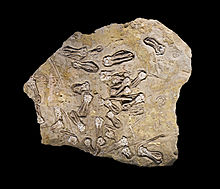Artinskian
| Artinskian | |||||||||||||||||||
|---|---|---|---|---|---|---|---|---|---|---|---|---|---|---|---|---|---|---|---|
| Chronology | |||||||||||||||||||
In the million years ago (Ma) according to the most recent revision of the International Commission on Stratigraphy (ICS) in 2022.[1] It was preceded by the Sakmarian and followed by the Kungurian .
Stratigraphy The Artinskian is named after the goniatite grits of Artinsk which was introduced by Urals, about 170 km southwest of Yekaterinburg. The stage was introduced into scientific literature by Alexander Karpinsky in 1874.[4]
Base of the ArtinskianThe base of the Artinskian Stage is defined as the Mesogondolella bisselli. In order to constrain this age, the ICS subcommission on Permian stratigraphy informally proposed a candidate GSSP in 2002, later followed by a formal proposal in 2013. The proposed GSSP location — the Dal'ny Tulkas roadcut in the Southern Urals, near the town of Krasnousolsky[5] — was eventually ratified in February 2022.[2]
U-Pb radiometric dating found that the base of the Artinskian was approximately 290.1 million years old (Ma), based on the position of the rock layer at the Dal'ny Tulkas roadcut containing the FAD of S. whitei relative to three precisely dated ash beds surrounding it.[6] Earlier radiometric reported a much younger age of 280.3 Ma for the Sakmarian-Artinskian boundary. Top of the ArtinskianThe top of the Artinskian (and the base of the Kungurian) is defined as the place in the stratigraphic record where fossils of conodonts Neostreptognathodus pnevi and Neostreptognathodus exculptus first appear.[4] The proposed GSSP candidate — the Mechetlino section (Southern Urals).[7] Artinskian Warming EventAround 287 million years ago occurred an interval of pronounced warming known as the Artinskian Warming Event (AWE). This period of brachiopod fossils,[11] with arid and semi-arid conditions expanding across much of Pangaea as glaciers receded to refugia in the polar regions of Gondwana.[8]
References
External links
| |||||||||||||||||||
